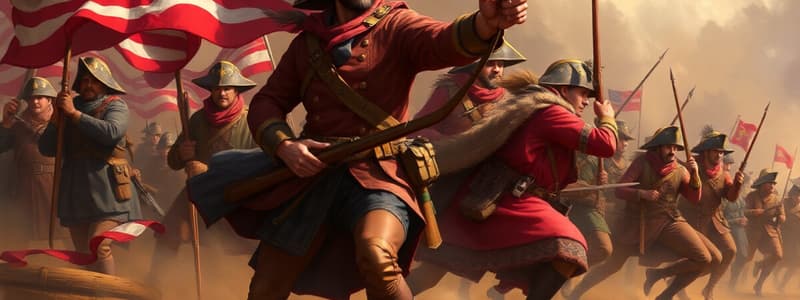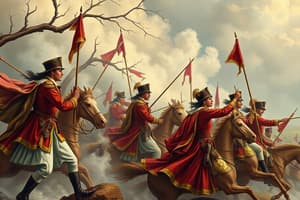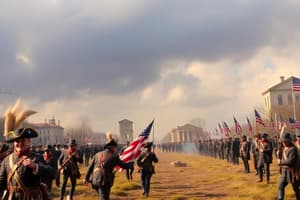Podcast
Questions and Answers
What challenges did the American army face at the onset of the war?
What challenges did the American army face at the onset of the war?
- High morale and ample resources
- Advanced military strategies and equipment
- Abundant supplies and well-trained officers
- Limited numbers and poor training (correct)
How did the British strengths contribute to their initial successes in the war?
How did the British strengths contribute to their initial successes in the war?
- Overwhelming numbers and superior training (correct)
- Lack of resources and geographical disadvantages
- Strong alliances with European countries
- Uncontested control over coastal areas
What was one reason black individuals joined the Continental army?
What was one reason black individuals joined the Continental army?
- Desire to fight for independence
- Promise of monetary compensation
- Hope for freedom as a reward (correct)
- Coercion by military leaders
Which factor did not hinder the British efforts during the war?
Which factor did not hinder the British efforts during the war?
What effect did 'The Crisis' by Thomas Paine have on the Continental army?
What effect did 'The Crisis' by Thomas Paine have on the Continental army?
Which battle is considered the turning point in the American Revolutionary War?
Which battle is considered the turning point in the American Revolutionary War?
Why did the British shift their focus to the southern colonies?
Why did the British shift their focus to the southern colonies?
How did George Washington alter his war strategy midway through the conflict?
How did George Washington alter his war strategy midway through the conflict?
What was a significant outcome of the American victory at the Battle of Trenton?
What was a significant outcome of the American victory at the Battle of Trenton?
What prompted northern states to begin banning slavery after the war?
What prompted northern states to begin banning slavery after the war?
Flashcards are hidden until you start studying
Study Notes
The American Army and the War
-
Weaknesses of the American Army:
- Lack of manpower
- Poorly trained soldiers
- Insufficient supplies, including food, weapons, and ammunition
-
Strengths of the American Army:
- Strong patriotism and a reason to fight for freedom
- Assistance from foreign allies, particularly France
- Strong leadership under George Washington
The British Army and the War
-
Strengths of the British Army:
- Larger and more experienced army compared to the Americans
- Well-equipped and supplied troops
-
Weaknesses of the British Army:
- Distance between England and America, making communication and resupply difficult
- Difficulty convincing the English population of the importance of the war
- Lackluster leadership
African Americans and the War
-
Motivation for Joining:
- African Americans, particularly enslaved people, joined the Continental Army with the hope of gaining their freedom.
-
Change in Attitudes Towards Slavery:
- After the war, many northern states started abolishing slavery, reflecting evolving public opinion.
Turning Points and Key Battles
-
Battle of New York:
- British victory resulted in initial setback for the Americans.
-
The Crisis:
- A pamphlet by Thomas Paine, which re-energized American troops and contributed to their success against the Hessians in Trenton.
- It emphasized the importance of fighting for freedom and independence.
-
Battle of Trenton:
- American victory on Christmas night, 1776.
- Washington’s troops surprised the Hessians, capturing 868 soldiers with no American casualties.
- Reinvigorated American morale and demonstrated the potential for defeating the British.
-
Battle of Princeton:
- A week after Trenton, American forces captured 300 British troops at Princeton, further solidifying their momentum.
-
Shifting War Strategy:
- Washington adopted a defensive strategy to preserve his forces and eventually outlast the British.
-
Battle of Saratoga:
- Turning point of the war.
- American victory led to France joining the war as an ally, providing critical resources and support.
-
Battle of Monmouth:
- A battle that ended in an inconclusive draw, but showed the strength of the American army against a larger British force.
British Shift to the South
-
British Strategy:
- The British shifted their focus to the south, hoping to exploit potential Loyalist support.
-
American Strategy:
- American guerrilla tactics, led by Nathaniel Greene, constantly harassed the British troops, draining their resources and delaying their progress.
- The strategy aimed to exhaust the British forces and turn the tide of the war.
Studying That Suits You
Use AI to generate personalized quizzes and flashcards to suit your learning preferences.




